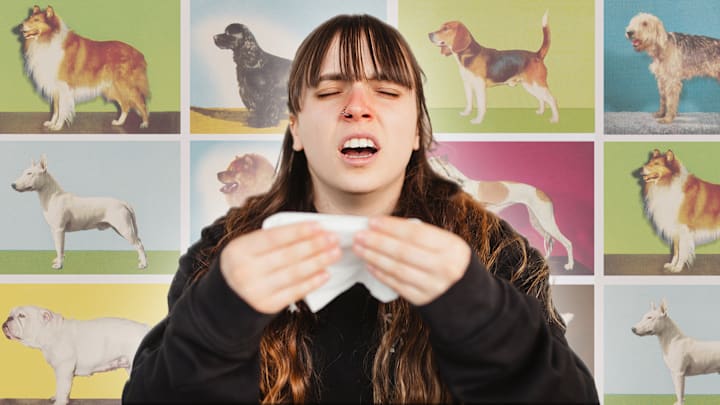For those whose eyes water and nose runs at the mere sight of a dog or cat, the idea of a pet that doesn’t cause allergies is certainly enticing—particularly when 10 to 20 percent of people across the globe have pet allergies, and 70 percent of Americans have a pet in their home. Unfortunately, a truly hypoallergenic animal doesn’t exist.
What Causes Pet Allergies?

“There is no such thing as a universally hypoallergenic pet,” Dr. Payel Gupta, a board-certified allergist and the medical director of Allergy, Asthma and Immunology at LifeMD.com, tells Mental Floss. “One dog might not cause allergies for one person, whereas that same dog will cause allergies in the next.” In fact, all dog and cat breeds can cause allergy symptoms.
Gupta warns that breeders inaccurately advertise potential pets as “allergy-free” when it’s simply not true. “Breeds we normally associate with being hypoallergenic, like poodles, are marketed as such because they shed less than other breeds,” she says. “But that doesn’t mean the animal is hypoallergenic. If you’re truly allergic to dogs or cats, you could potentially have a reaction to any pet.”
Shedding isn’t even the main factor when it comes to deducing a pet’s likelihood of causing allergies.
“Most people believe that allergies are caused by a dog or cat’s fur, but the real culprit is a protein that’s found in their saliva, tears, dander, and urine,” Gupta says. When a pet licks themselves or pees, those proteins stick to their hair or fur. Shedding can certainly spread these proteins around your home, but so can the release of dander, which are dead skin cells similar to human dandruff. Pet hair and fur can certainly carry other common allergens, such as dust mites, mold, and pollen, but Gupta says, “the hair and fur is not actually the allergen.”
Problems can arise from this misunderstanding of pet allergies.
“I have had families get dogs that are termed ‘hypoallergenic’ only to find that the dog is affecting their child with allergies,” Gupta says. “Then the member of the family with pet allergies will have health consequences that can cause such extreme issues as difficulty breathing, and ultimately, it may mean they have to be on multiple medications, which all have potential side effects, in order to stay healthy around that pet.”
How to Deal with Pet Allergies

Melanie Carver, the chief mission officer of the Asthma and Allergy Foundation of America, recommends potential pet owners with known allergies speak to an allergist before adding a new animal to their home. “It’s about each person’s individual tolerance and allergy triggers,” she says. “Depending on your diagnosis, there may be options. For example, people who are allergic to a specific protein in feline saliva may be able to feed their cat a special cat food that helps neutralize it.”
Gupta also suggests fostering a pet before permanently committing to the new member of the family. “Looking at a pet in the pet shop for five minutes may not reveal the allergy,” she says. “The only way to determine if you are safe around one dog or cat compared to another is to live with the pet.”
For those who exhibit some allergic symptoms to all pets, Carver has further guidance: “Managing allergies with a pet means taking steps to reduce exposure to allergens by keeping pets out of bedrooms or sleeping areas, or by wearing a mask while grooming your pet, preferably outside, and washing your hands after petting or touching your pet.” Regularly cleaning your home, and opting for hard flooring over carpeting, helps, too, as does bathing your pet—within reason. As Gupta says, “not every animal is meant to be washed frequently, and we want to keep our pets safe, too.”
